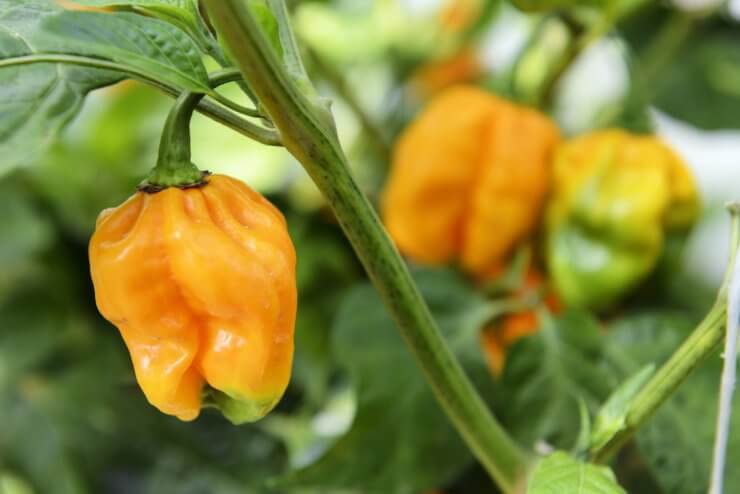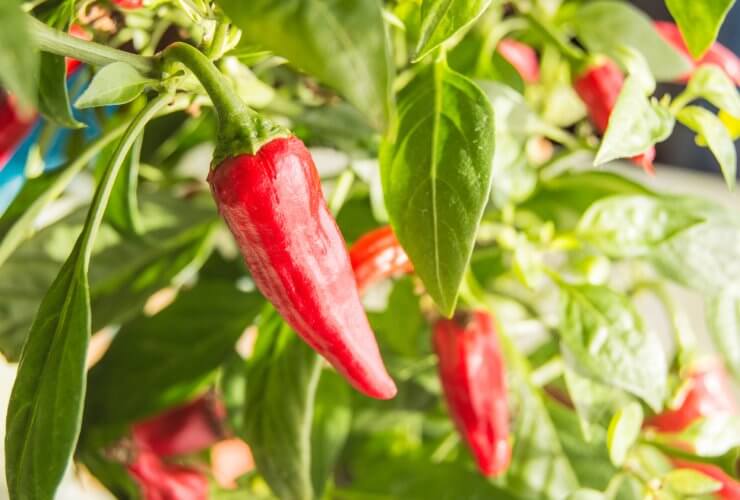
Most of us don’t think very much about how to grow hot peppers indoors. After all, peppers are sort of known for their love of sunlight and summer temperatures. But who would we be as gardeners if we didn’t at least try?
Here’s a bit of a spoiler, you can indeed grow hot peppers indoors, although it does take a little more than tossing some pepper seeds into a pot. Like any vegetable you grow indoors, it may take some extra planning and preparation to grow hot peppers indoors. But that doesn’t mean you can’t do it.
Of course, there are some things to consider. Hot peppers do need sunlight, which can be a bit hard to come by in the winter here in the northern hemisphere. They also need plenty of warm temperatures, which may be in limited supply as you get into cooler plant hardiness zones. We’ll deal with these issues below, but if you’re ready for a fun and spicy challenge, let’s get into the basics of how to grow hot peppers indoors.

How to grow hot peppers indoors: Your 7-step guide to spicy plant life
There are several things to consider when you think about how to grow hot peppers indoors. Everything from the season to the variety of pepper to lighting can significantly impact your success.
1. Variety. Variety is a good place to start. Since you’re growing peppers indoors, it’s reasonable to assume that a variety well-suited to either containers or a hydroponic setup is a smart choice. Certain varieties of Jalapeño, Cayenne, Habenero peppers, and others are adapted to work well in containers.
2. Container. The size of the plant will determine what type of container you need to use. Plants in a hydroponic system generally don’t require as much space as they do in containers, since the nutrients are easier to access. Generally speaking, however, go for a 3-5 gallon container. It will seem large at first, but as your peppers mature, they will use up that space.
3. Growing medium. In thinking about how to grow hot peppers indoors, this might be one of the most critical factors. Hot peppers enjoy light, aerated soil with plenty of nutrients.
4. Light. Now we’re getting into the tricky stuff – although it’s not all that tricky. Whether you’re opting for hydroponic growing or sticking with the traditional pot and soil, hot peppers like a lot of light. Peppers need a minimum of six hours of sunlight each day, BUT they really thrive with closer to 12 hours. You’re going to have a hard time giving them that kind of light indoors. Even in the best situation, sunlight loses some of its oomph when it passes through windows. Therefore, one secret for how to grow hot peppers indoors is to use a grow light.
5. Temperature. Hot pepper plants can handle a wide range of temperatures. That said, they grow best when the thermometer hovers around 75 or 80 degrees Fahrenheit. This might be one of the more challenging aspects of growing peppers indoors. For the sake of your heating bill, you can’t really turn the heat up that high in the winter. If you’re lucky enough to have zoned heating, that could work. Or you could add a small space heater to keep your peppers warm. However, we don’t live in an ideal world, so those peppers just might have to deal with 68 degrees. Or they can go get a job and contribute to the heating bill.
6. Fertilizer. If you’re going the hydroponic route, fertilizer is probably built into your nutrient mixture, so you don’t need to worry about this. However, if you’re growing hot peppers in containers, you’ll need to feed your plants. The Penn State extension program recommends a balanced fertilizer up until the plants begin flowering, at which point they recommend switching to a high-potassium blend.
7. Pollination. Yes, peppers are self-pollinating, which means you don’t have to do much. You may, however, need to give them a gentle shake now and then to make sure the pollen spreads. Alternatively, you can keep a small fan going, which is also an excellent way to help keep any fungus from having a place to settle.
That’s it, my friends! Now just sit back and wait for your peppers to grow and ripen. A word to the wise about harvesting and handling your peppers: Wear gloves.
Let me say it louder: WEAR GLOVES!!!
Seriously, you only need to get some hot pepper juice on your hands once and rub your eye to learn this lesson. Don’t ask me how I know.
Otherwise, enjoy! Hot peppers can also add some gorgeous color to your home, so don’t be afraid to grow a few varieties.
Have you learned how to grow hot peppers indoors? Any advice or tips you’d like to share?


 Previous
Previous

